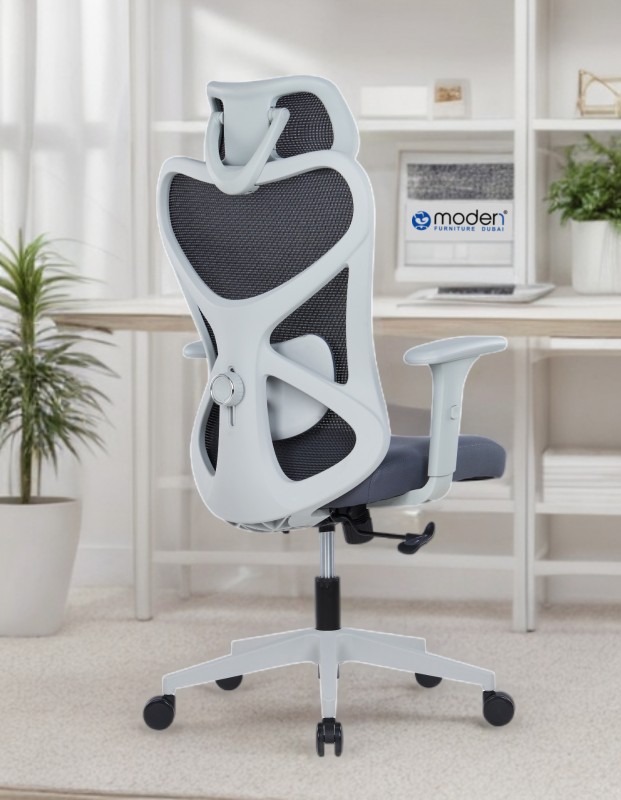
Office Chairs That Support a Balanced Sitting Posture
Introduction
Spending hours seated can take a toll on your posture—unless your chair is built for balance. A balanced sitting posture keeps your spine aligned, distributes your weight evenly, and reduces stress on pressure points. The right office chair doesn't just offer cushioning—it actively supports this ideal posture. In this article, we’ll explore features to look for in posture-supportive chairs and why they matter.
1. The Role of Lumbar Support
A balanced sitting posture starts with the lower back. Chairs with adjustable lumbar support maintain the natural inward curve of your spine, preventing slouching and discomfort during extended periods of sitting.
2. Seat Depth and Pan Adjustment
A chair with adjustable seat depth lets you maintain a gap of 2–3 inches between the seat edge and the back of your knees. This promotes circulation while helping you stay centered in your seat, promoting posture alignment.
3. Proper Pelvic Positioning
Chairs that encourage a slight forward tilt or neutral pelvis position help keep your hips aligned under your spine. This reduces the tendency to slouch or hunch forward, which often leads to back and neck strain.
4. Height Adjustment for Grounded Feet
Balanced posture means both feet flat on the ground. Chairs with a wide range of seat height adjustments ensure users of all heights can find a position where their knees are level with their hips, avoiding unnecessary strain.
5. Synchronous Tilt Mechanism
A chair that tilts in sync with your body movement keeps you supported when you lean back. This function allows for dynamic sitting—helping you shift positions while keeping your spine balanced and aligned.
6. Contoured Seat Cushioning
Balanced sitting posture depends on more than back support. The seat cushion must distribute weight evenly and contour to your body's shape, reducing pressure buildup in the thighs and hips.
7. Adjustable Armrests for Shoulder Alignment
If your arms are too high or too low, your shoulders tense up. Chairs with height- and width-adjustable armrests help you keep your arms relaxed, which improves upper-body posture and prevents fatigue.
8. Supportive Headrest for Neutral Neck Position
A headrest that aligns with the natural curve of your neck can help reduce forward head posture. This is especially important during moments of relaxation or when leaning back in your chair.
9. Balanced Weight Distribution
Well-designed chairs offer even support across the entire seating surface. This prevents one side from carrying more weight than the other—an important factor for avoiding spinal imbalances and pressure points.
10. Encouraging Active Sitting
Chairs that allow controlled movement and slight rocking can promote micro-adjustments that engage your core and help maintain posture without conscious effort.
Additional Considerations for Balanced Sitting
Evaluate Your Desk Height Compatibility
Even the best chair can't fix posture issues caused by a desk that’s too high or too low. Make sure your chair and desk work together to allow a 90-degree elbow angle.
Use Footrests If Necessary
If your chair is too high for your feet to rest flat, a footrest can help you maintain that grounded, balanced position crucial for posture.
Check for Forward Tilt Option
Some ergonomic chairs include a forward seat tilt, which encourages a natural pelvic tilt and spinal alignment—great for tasks that require leaning forward.
Favor Breathable and Supportive Materials
High-density foam or breathable mesh can maintain posture without making you feel stiff or sweaty, helping you stay balanced and comfortable longer.
Ensure Backrest Height Matches Your Torso
The height of the backrest should support the full length of your back. Some chairs allow adjustable backrest height, especially important for taller users.
Don’t Overlook Base Stability
A five-point wheelbase helps prevent tipping or imbalance when reclining or reaching, keeping your sitting position secure.
Evaluate Cushion Firmness
Overly soft seats can lead to sinking and imbalance. Look for medium-firm cushions that support your posture over long sessions.
Test for Recline Lock Functions
Chairs that let you lock in a partially reclined position allow you to alternate postures while staying well-supported.
Monitor Hip-to-Knee Angle
A hip angle slightly more open than 90 degrees is often better for posture. Some ergonomic chairs are designed to support this slight tilt naturally.
Consider Daily Sitting Time
The more hours you sit, the more important posture support becomes. Opt for a high-end ergonomic chair if your work involves sitting most of the day.
Recommended Products:

-
Ucomfort Super Ergonomic Executive Office Chair – White
Designed with dynamic lumbar support, breathable mesh, and a contoured seat, this chair promotes a balanced and ergonomic sitting position ideal for long work hours.
-
Chablo Executive High Back Ergonomic Office Chair – Black
With a high backrest, supportive headrest, and adjustable features, this chair ensures your entire spine—from lumbar to neck—remains aligned and balanced throughout the day.
Final Thoughts
A chair that supports a balanced sitting posture does more than make you feel comfortable—it actively helps you stay aligned, productive, and pain-free. From adjustable lumbar support to seat depth and tilt functions, every feature contributes to better posture. Choosing the right chair is a long-term investment in your health and work efficiency.
FAQ
Q: What defines a “balanced” sitting posture?
A: It’s a position where your spine maintains its natural curve, your feet are flat on the ground, and your weight is evenly distributed without pressure points.Q: Do all ergonomic chairs support balanced posture?
A: Not always. Look for chairs with adjustable lumbar support, seat depth, tilt functions, and armrests that allow for a truly posture-aligned fit.


